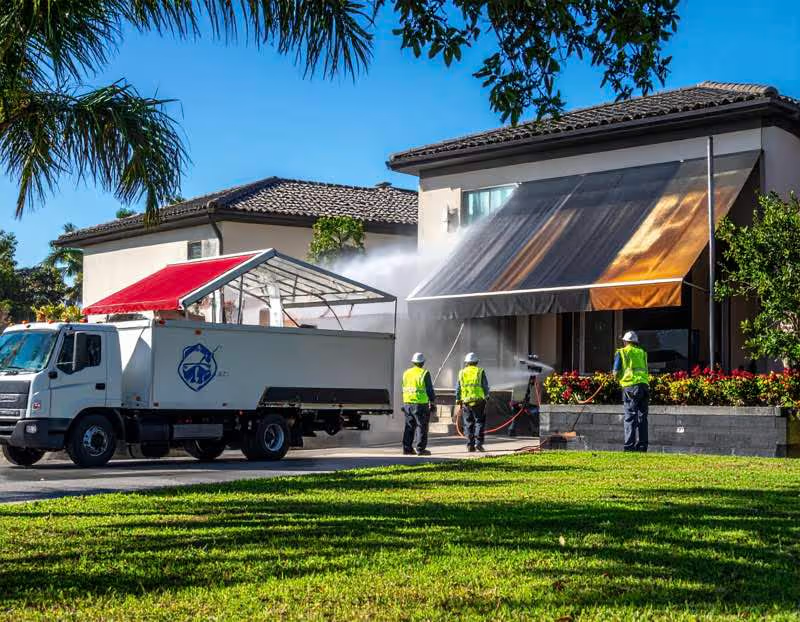
Professional Awning Cleaning in Orlando: Remove Mold, Mildew & Algae from Fabric & Metal Awnings
Professional awning cleaning in Orlando tackles the mold, mildew, and algae that thrive in Florida's humidity, restoring your fabric and metal awnings to like-new condition without causing damage or fading the colors.
How Do You Clean Awnings in Orlando?
- Inspect awning fabric for tears or weak seams before cleaning
- Rinse loose dirt and debris with low-pressure water
- Apply mold-safe cleaning solution designed for outdoor fabric
- Let solution dwell 10–15 minutes to break down algae and mildew
- Gently agitate stubborn spots with soft-bristle brush
- Rinse thoroughly with low-pressure water from top to bottom
- Allow awning to air-dry completely before retracting or rolling
This process works for most fabric and canvas awnings in Central Florida. Metal awnings can handle slightly higher pressure on frames, but fabric always needs gentle treatment.
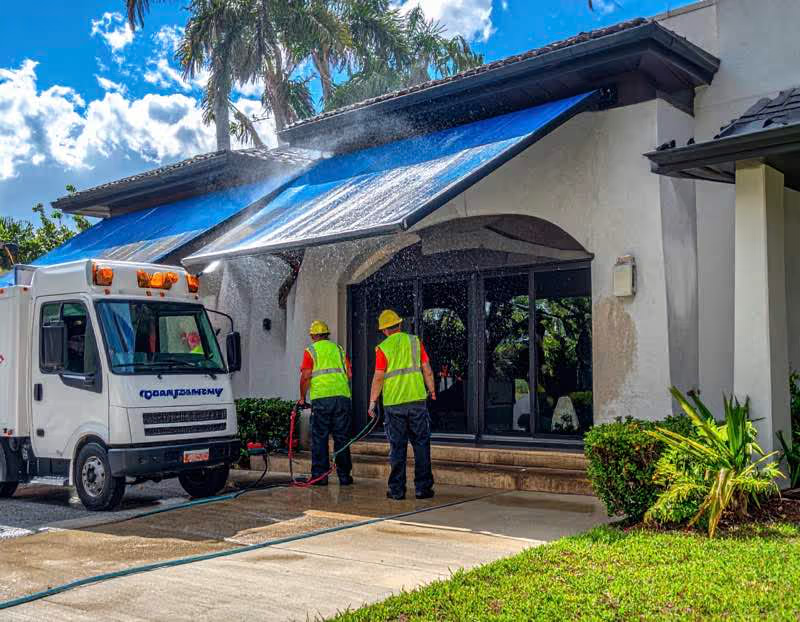
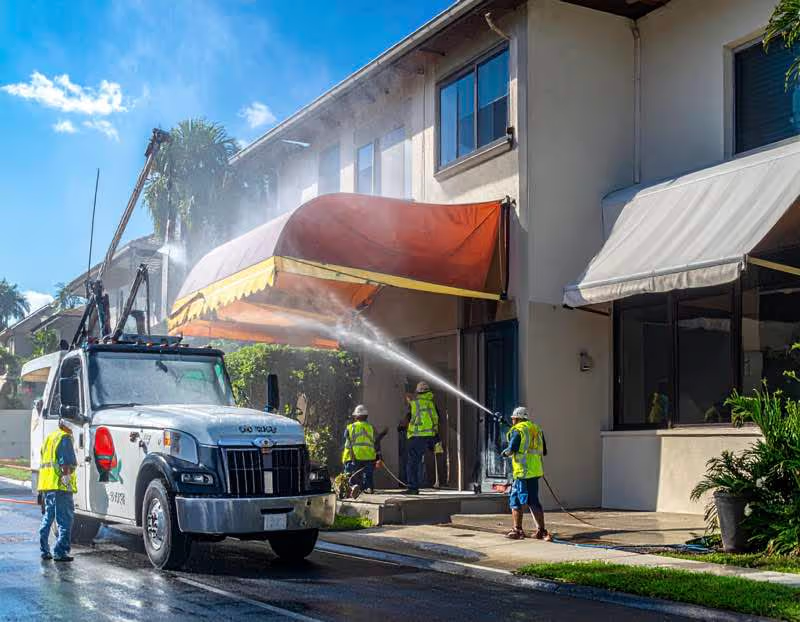
Low-Pressure Soft Washing Safely Removes Mold and Algae from Fabric Awnings
Homeowners in Winter Park and Baldwin Park often have fabric awnings over patios, windows, or storefronts. These awnings look great until mold takes over.
Soft washing uses one-third the pressure of traditional power washing. This protects your awning's stitching and fabric. High pressure tears seams and pushes water through the weave, causing damage you can't always see right away.
Orlando's humidity averages over 75% year-round. This makes mold grow on fabric awnings faster than in most other U.S. cities. The dampness never fully goes away, even during our "dry" season from November through April.
I've cleaned awnings in College Park where homeowners tried pressure washing themselves. The fabric looked clean for about two weeks, then the mold came back darker than before. Why? Because high pressure pushes spores deeper into the fabric instead of killing them at the surface.
Professional soft washing kills mold at the root. We use biodegradable solutions that break down algae and mildew without bleaching your awning's color. The low pressure rinses away dead growth without damaging the fabric structure. This same gentle approach works for commercial buildings where appearance and durability matter most.
Your awning will dry faster after soft washing too. Less water penetration means less time waiting before you can retract or use the space underneath.
Orlando's Humidity Causes Green Algae and Mildew Buildup on Canvas Awnings
Commercial properties in downtown Orlando and Lake Nona struggle with storefront awnings that turn dark or discolored. That green-black color isn't just dirt. It's algae and mildew feeding on your awning fabric.
Professional treatment eliminates algae at the root and restores your awning's original color. We don't just spray and rinse. The cleaning solution needs time to penetrate the algae colonies growing in the fabric weave.
Afternoon thunderstorms from June through September keep Orlando awnings damp almost daily. These storms roll in around 2 PM, dump rain for 30 minutes, then leave everything wet for hours in the humidity. This creates perfect conditions for algae to spread.
Algae doesn't just look bad. It actually degrades canvas and acrylic awning fabrics over time. The organisms produce acids as they grow, which weakens fibers and shortens your awning's lifespan.
I worked on a restaurant awning in Thornton Park last month. The owner thought the dark streaks were stains from the building's brick. Once we treated the algae, the awning went from looking gray-green to its original burgundy red. The difference shocked everyone walking by that day.
Canvas awnings cost thousands to replace. Regular cleaning every 6-12 months prevents that algae from permanently embedding into the fabric. You'll spend a few hundred dollars on cleaning versus several thousand on replacement. According to the Industrial Fabrics Association International, proper maintenance and cleaning of awning fabrics can extend their service life by 50% or more, making professional care a smart investment for commercial and residential properties.
You Can Clean Awning Fabric Without Removing It from the Frame
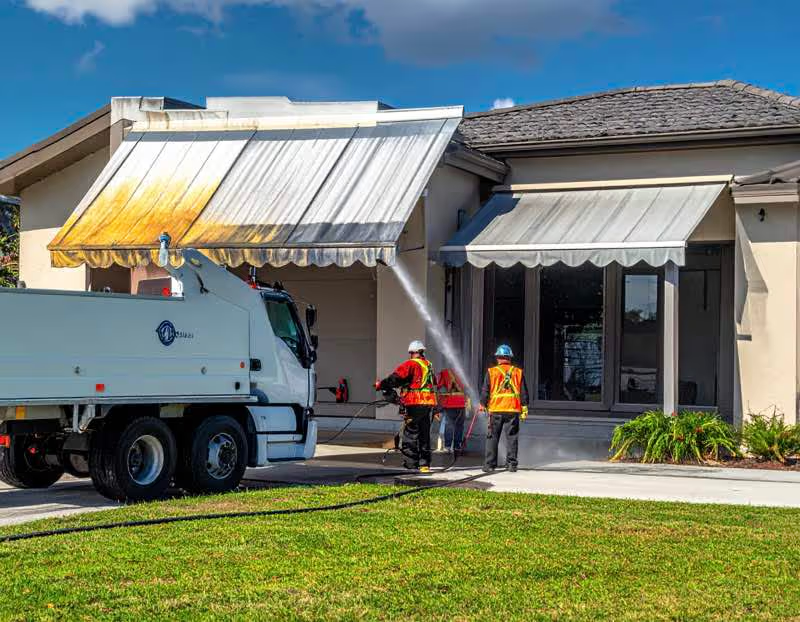
Residential clients in Dr. Phillips and Windermere often ask if we need to take their awnings down for cleaning. The answer is no for most awnings.
In-place cleaning saves you labor costs and prevents damage from detaching retractable awning mechanisms. Those mechanisms have springs, cables, and adjustment points that can be tricky to reassemble correctly.
Many Orlando homes have fixed metal awnings that can't be easily removed without professional help. These awnings attach directly to wall studs and removing them risks damage to your home's exterior.
We clean awnings where they hang. Our soft washing equipment reaches up to three stories high, so even second-floor window awnings get cleaned without removal.
The process is straightforward. We protect the area below the awning, apply cleaning solution from the ground or a ladder, let it work for 10-15 minutes, then rinse thoroughly. The whole job takes about an hour for a typical residential awning.
Retractable awnings need extra care. We never clean them in the rolled-up position. They must be fully extended so we can reach all the fabric and ensure complete drying afterward.
Some older awnings with rust damage or torn seams might need removal for repair. We'll tell you upfront if that's the case. Most of the time, though, your awning stays right where it is.
Underside Awning Cleaning Eliminates Hidden Mold in Covered Areas
Restaurant and café owners in Thornton Park with outdoor seating often overlook the underside of their awnings. That's where mold loves to hide.
Cleaning the underside removes health hazards and improves air quality for guests seated beneath awnings. Nobody wants to eat dinner with mold spores floating down into their food.
Condensation from air-conditioned buildings in Orlando creates moisture on awning undersides even during dry season. Cold air inside meets hot humid air outside, and water forms on the fabric's underside. This moisture doesn't evaporate as quickly because the underside stays shaded.
I've seen black mold colonies the size of dinner plates on awning undersides. From the ground, the awning looked fine. But when you walked underneath and looked up, the problem was obvious.
Commercial awnings over outdoor dining areas need underside cleaning twice a year minimum. The combination of food smells, moisture, and shade creates ideal mold conditions.
Residential awnings over patios have the same issue. You're sitting outside enjoying your coffee, and mold is growing on the fabric six feet above your head. Most homeowners never notice until someone points up and asks, "What's that dark stuff?"
We clean both sides of every awning. The top gets rid of visible algae and dirt. The underside eliminates hidden mold and mildew. Both sides need attention for a complete cleaning.
Metal and Aluminum Awning Frames Need Different Cleaning Than Fabric
Homeowners in College Park with vintage aluminum awnings face a different challenge than fabric awning owners. Metal and aluminum frames need different cleaning than fabric.
Higher pressure settings clean oxidation and dirt from metal without risk of tearing or staining. We can use up to 2000 PSI on metal frames, compared to under 500 PSI on fabric.
Salt air from nearby coastal areas and lake spray in Orlando causes faster corrosion on metal awning frames. Even though we're not directly on the coast, salt particles travel inland and settle on outdoor surfaces.
Aluminum awnings develop white oxidation that looks like chalk. This oxidation protects the metal underneath, but it looks terrible. We use specialized cleaners that remove oxidation without stripping the metal's protective coating.
Metal awnings also collect black streaks from algae and mildew, just like fabric. The difference is we can be more aggressive with cleaning metal. Brushes, higher pressure, and stronger solutions all work fine on metal frames.
Many Orlando homes built in the 1950s through 1970s have original aluminum awnings. These vintage awnings add character to the home, but they need regular maintenance. Cleaning every 12-18 months keeps them looking great and prevents permanent corrosion.
If your awning has both metal frames and fabric panels, we adjust our approach for each material. Lower pressure for fabric areas, higher pressure for metal frames. One size doesn't fit all when it comes to awning cleaning.
Regular Awning Maintenance Prevents Permanent Staining in Florida's Climate
Property managers across metro Orlando maintaining multiple residential or commercial buildings know awnings need attention. But many don't realize how quickly Florida's climate damages neglected awnings.
Quarterly or biannual cleaning prevents mold from embedding into fabric fibers, extending awning lifespan. Once mold grows into the fabric for more than a year, it becomes nearly impossible to remove completely.
Hurricane season debris settles on awnings and holds moisture against fabric. Leaves, oak pollen, and Spanish moss fall on awnings during storms. When wet debris sits on fabric for weeks, it creates permanent dark spots that won't come out even with professional cleaning.
I've seen awnings in Lake Nona that looked brand new after just two years because the owners cleaned them every six months. I've also seen awnings in Baldwin Park that needed replacement after five years because they never got cleaned. The difference comes down to maintenance.
Florida's climate is harder on awnings than northern states. You can't treat awning maintenance the same way someone in Ohio would. What works up north doesn't work here.
Set a reminder to clean your awnings twice a year. Schedule one cleaning before hurricane season starts in June, and another in November after hurricane season ends. This timing handles both the wet summer months and the debris from fall storms.
Commercial awnings need more frequent attention. High-traffic businesses should clean awnings quarterly, especially if they're part of your building's curb appeal and branding.
The investment pays off. A $200-300 cleaning every six months saves you $2,000-5,000 in awning replacement costs. Simple math.
Frequently Asked Questions About Awning Cleaning in Orlando
Should you pressure wash an awning in Orlando?
Use low-pressure soft washing under 500 PSI for fabric awnings. Standard pressure works for metal frames only. High pressure tears fabric, pushes water through seams, and damages stitching. Most Orlando awnings need gentle treatment because our humidity already stresses the fabric.
How do I remove green algae from my awning in Central Florida?
Apply algae-specific cleaner, let it dwell 10-15 minutes, then rinse with low pressure to avoid fabric damage. Don't scrub aggressively or you'll push algae deeper into the weave. The cleaning solution does most of the work if you give it enough time. Orlando's algae is stubborn, so patience beats elbow grease.
Can you clean my awning without taking it down?
Yes, in-place cleaning is safer for retractable and fixed awnings common in Orlando homes. We reach awnings up to three stories high without removal. Taking awnings down risks damage to mounting brackets and retractable mechanisms. Most cleaning jobs don't require removal at all.
How often should I clean my awning in Orlando's humidity?
Every 6-12 months depending on shade coverage, proximity to trees, and exposure to afternoon rain. Awnings under tree cover need cleaning every six months. Full-sun awnings might last 12 months between cleanings. Commercial awnings need quarterly service. Watch for dark streaks as your signal to schedule cleaning.
Is it safe to roll up my awning after it gets wet from rain?
No, always let fabric dry completely to prevent mildew growth, especially critical in Florida's humid climate. Rolling up wet fabric traps moisture and creates perfect mold conditions. Even if the outside feels dry, moisture can be trapped inside the rolled fabric. Wait at least 24 hours after rain before retracting your awning.
What's the best way to clean awning windows in Orlando?
Use low-pressure rinse and non-abrasive cleaner on glass. Avoid harsh chemicals that damage surrounding awning fabric. Clean windows and awnings together for best results. The window cleaning solution shouldn't touch awning fabric, and awning cleaner shouldn't sit on glass. We protect both surfaces during the cleaning process.
Ready to restore your Orlando awning? Contact Pressure Washing Guys at (407) 412-4015 or visit pressurewashingguysflorida.com for same-day service in Winter Park, Lake Nona, Dr. Phillips, Baldwin Park, and throughout Central Florida. We're fully licensed and insured, with expertise in both fabric and metal awning cleaning.
Serving Orlando area: 5295 Creekside Park Ave, Orlando, FL 32811

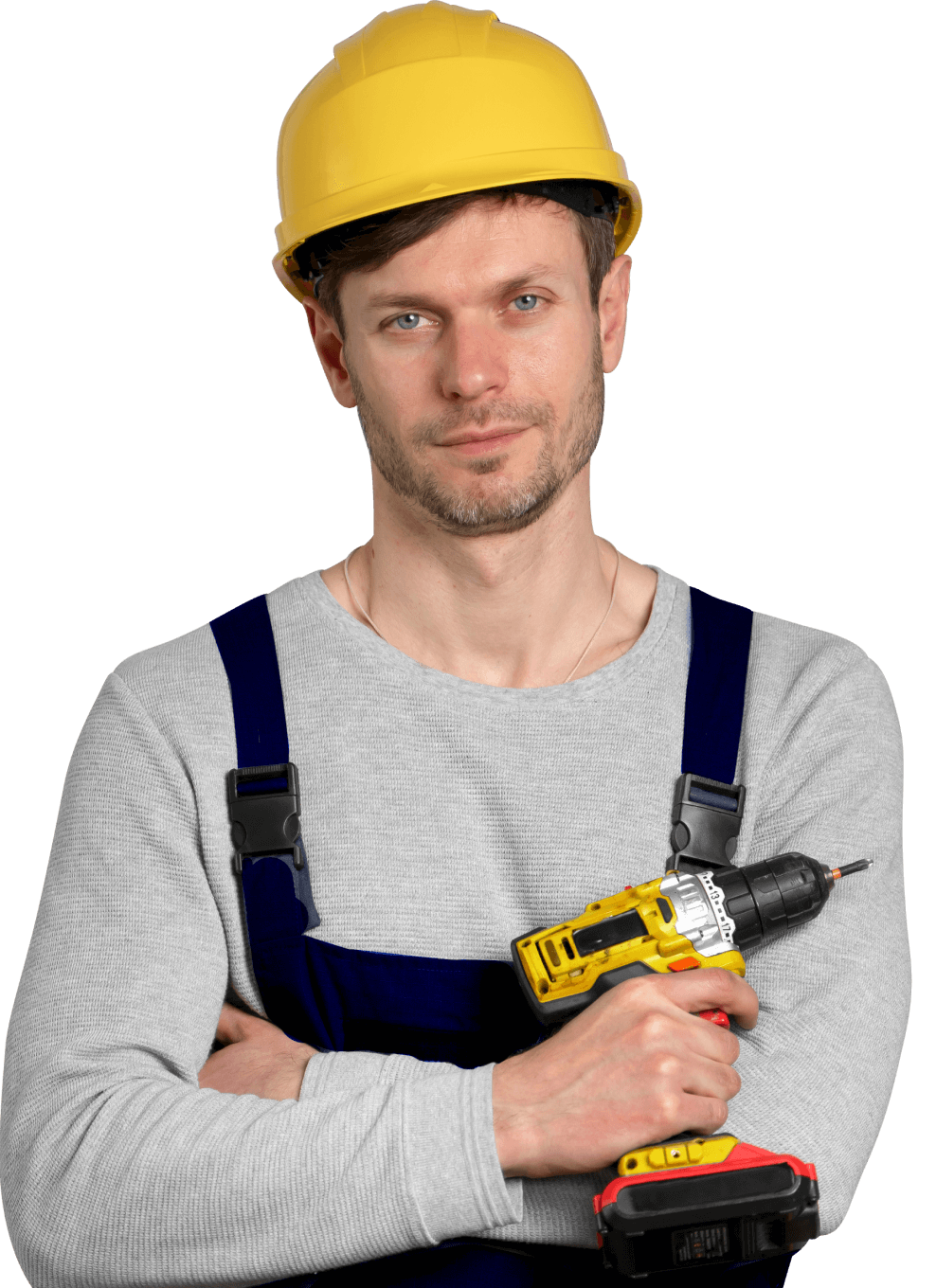
Get a quote within an hour for your project!
Our team responds fast so you can start your project
without delays or guesswork.

